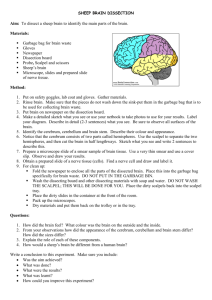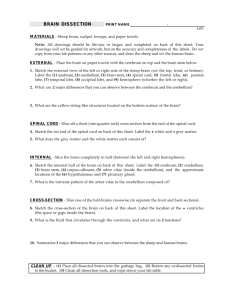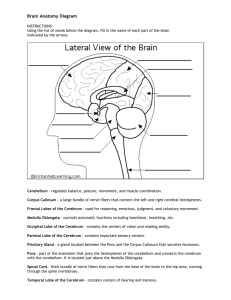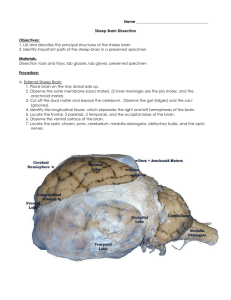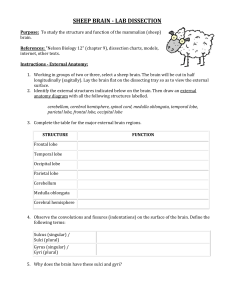Sheep Brain Dissection Report
advertisement
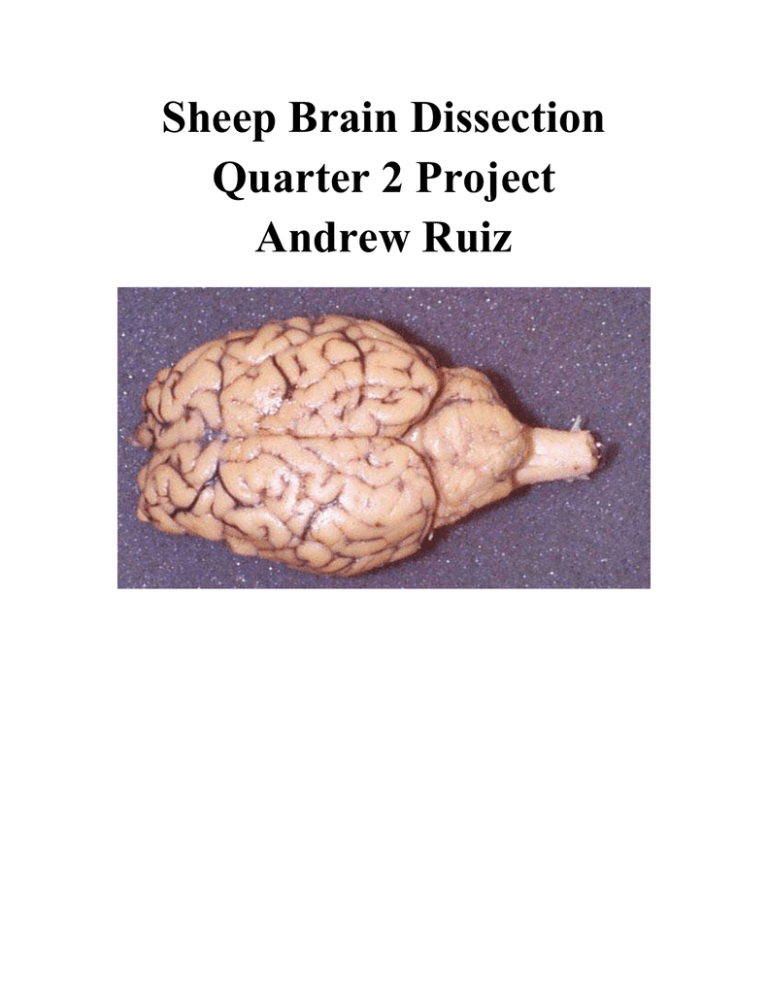
Sheep Brain Dissection Quarter 2 Project Andrew Ruiz Andrew Ruiz John Horton Science Class 1-2-13 Sheep Brain Dissection Report A one in a lifetime experience presented itself recently in my Biology Class. I got a chance to dissect a sheep brain and get up close and personal with the structure of its unique design. With each type of brain there will be differences in size, structure, and brain regions, but the general structures and their area of location are relatively the same or very similar. During this lab I cut open a sheep brain and labeled all the divided structures that allow a sheep to survive and sustain life when everything worked as one. Taking part in this experiment helped me better understand how the brain works and what makes the human brain stand out from all the rest. Before taking part in this experiment I had to prepare myself with the necessary materials to dissect this sheep brain such as. - Gloves - Goggles - Toothpicks/Labels - Pointers - Scissors - Tweezers - Scalpel Sheep Brain Dissection Guide and Steps when completing this procedure. 1. Place the brain on a dissection tray, dorsal side up 2. Observe the structure of the of the sheep brain 3. Identify the cerebrum and the medial longitudinal fissure which separates the right and left hemispheres of the cerebral cortex 4. Locate the four lobes of the cerebrum. At the anterior portion of the brain is the frontal lobe, which controls motor functions. Dorsal to this side is the parietal lobe, which receives and processes somatic sensory information. Inferior to the parietal lobe are the temporal lobes that take care of receiving and processing auditory sensations. The dorsal portion of the cerebrum makes up the occipital lobe, which receives and processes sensations from the eyes. 5. Locate the cerebellum, which is inferior to the occipital lobe of the cerebrum. The cerebellum has an outer cortex and is folded it controls muscle coordination. 6. Place the brain on the dissecting tray, ventral surface up. Locate the medulla, pons, brain stem and spinal cord. 7. Next identify the olfactory bulb, which lies below the frontal lobe of the cerebrum and the optic chiasma. The optic chiasma looks like an x-shape structure that is formed by the crossover of the right and left optic nerves. 8. Place the brain on a dissection tray, dorsal side up. Using your fingers, gently widen that medial longitudinal fissure. Insert a scalpel into the fissure and cut through the corpus callosum connecting the two cerebral hemispheres. Continue to cut, dividing the cerebrum, cerebellum, and brainstem into two longitudinal halves. 9. Each hemisphere contains a lateral ventricle, referred to as the first and second ventricles. Locate the third and fourth ventricles. The fourth ventricle connects to the central canal of the spinal cord and also connects to the third ventricle by a cerebral aqueduct. 10. With the cut side facing up, locate the following parts: thalamus, hypothalamus, pineal body, pons, and medulla. 11. Observe the cut surface of the cerebrum. In medial section, the white matter of the cerebellum forms a branched like pattern. 12. Locate the midbrain region, located inferiorly between the thalamus and pons. This area contains important nerve tracts. Dorsal areas of the midbrain are concerned with response to visual and auditory stimuli. 13. Make a cross section through a cerebral hemisphere just anterior to the thalamus. Examine the cross section and identify the inner white matter and outer gray matter. 14. Remove the cerebellum and the remainder of the cerebral hemisphere by dissecting away everything dorsal to the floor of the lateral ventricle. This will expose an unfolding of the cerebral cortex, called the hippocampus which is involved with emotion and memory. 15. Remove the hippocampus to locate the remainder of the thalamus. 16. Once you have observed all the structures of the brain, dispose of the specimen in accordance with your teacher’s instructions. After completing this dissection lab I realized many things that I didn’t know before about the brain. For example where structures are like the pons, medulla, and four lobes and how they help assist the brain in its everyday activity. I even discovered what the difference is between white matter and gray matter. The difference is white matter is located in the center on the brain and gray matter is located on the outside layer of the brain so they are fairly close but in different locations. Also that gray matter can gather more information and can hold it longer than white matter can. Taking part in this opportunity taught me what makes the human brain stand out in comparison to the sheep brain. An example can be we are considered smarter than a sheep because our brain is several times larger than a sheep’s brain which allows us to do many more special things that is not possible for any other organism on this planet. Also we have more folds in our brain that allows us to carry a lot more information compared to a sheep brain with much less. Lastly one key ability the human brain has that makes us different from any other species is our ability to talk and to think before we act likes most organisms that react off instinct. Many of these reason are why I recommend learning more about the brain because it can help you understand what makes our brain and other creatures brain function in the way they do in each of are similar but very different ways of life and help you know what affects your brain for better or for worse and how you can improve as a person based off this information.
